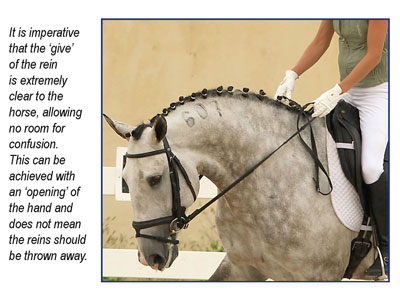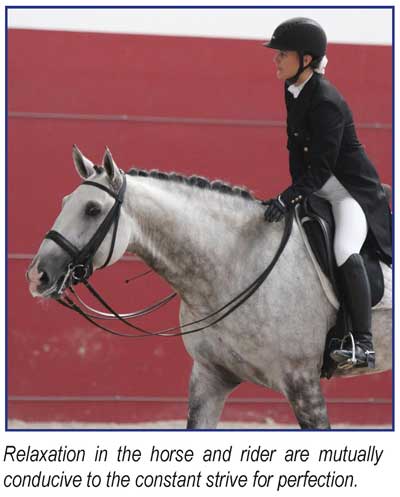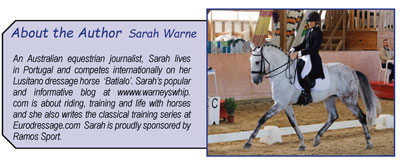|

When the horse relaxes... really give the rein, and make it abundantly clear that its relaxation corresponds with the total relaxation of the rider!
“Make it a habit to praise when the horse yields.” N.Oliveira (1998, 17).
And when yielding always remember it is better to reward too much than not enough. If the rider doesn’t make the reward clear to the horse there is the risk of confusing it as to what was required, and next time the horse will be reluctant to soften, or will simply not soften at all!
“It is always better to risk losing the contact a little, than not to yield at all.”N.Oliveira (1998, 30).
A firm yet effective rider will demand consistency and submission, but will achieve this long-term by telling the horse clearly when it has done the right thing. However, the hard part is that even the best trainer in the world can’t tell the rider exactly when to soften...
They can tell someone when they ‘should have’ softened, but, as riders, we must learn to feel the split second the horse accepts what the rider is asking and relaxes through its body.
The best way to help a rider feel when the horse softens, and thus learn the art of letting go, is at the halt. Halt the horse on the long side, and move the inside hand down and out and, remaining at halt, give a small squeeze on the rein, to flex the horse’s jaw towards the inside.
The minute the horse softens in the mouth towards the hand, release and pat.
This is the basis for the softening in all the other work, and so, until the horse learns to yield in response to a slight squeeze of the rein at the halt, riders will never establish true self-carriage and suppleness in all the rest.
“The hands have to be like concrete when the horse resists and like butter when he yields.”N.Oliveira (1998, 29).
Legs and hips are no different than the hands, or in fact a rider’s entire body, so riders must learn when to apply and when to relax the aids, as quickly and as sensitively as possible.
A good way to test the sensitivity and effectiveness of leg aids is at the walk . On a small circle, using bend to the inside with a soft and relaxed inside rein aid, apply the inside leg lightly onto the horse’s side, and gently allow him to move away from the inside leg on a small circle, pushing the quarters but keeping the shoulders stepping across also.
If the horse moves easily off your leg, you relax immediately, and reward him.
If not, apply the aid harder, until there is a response, then back off, and ask again softly, until the horse is moving off a light leg aid.
During the ongoing work, remember the same feeling, and when the horse moves away from the leg, or forward as he is asked, relax the aid. The rider’s legs should not be constantly on, they should ask, and then relax, and wait until they are needed again to remind, or to introduce a new exercise.
Hips are also crucial in not only the relaxation of the horse’s back, but also in the effectiveness of all the other aids. If a rider is tightening in the hip then they will usually also be drawing their legs up, and pressing into the horse’s sides constantly. A relaxed and open hip allows movement in the legs and enables the rider to effectively apply and then relax the leg aid in correspondence with the horse’s stride.
Riders can constantly strive for perfection, but the talent comes from knowing when to push and when to back off! 
“Don’t play the master all the time. The difficulty is to feel to what extent one has to intervene.” N.Oliveira (1998, 17).
The extent of the reward and intervention also depends on the horse’s ability, age, and stage of training. If the horse being worked is stiff, and is still learning how to relax and loosen through its body, the rider must reward it the very second it yields to flexion, stroking the horse, and telling it that it has done what was asked.
But if the horse is an experienced one that is very good, and very used to stretching and working through its back, more can be expected, and the rider would only relax when it gives its full relaxation first.
Another important thing to let go of as a rider, is frustration. Most riders are guilty of it at times, feeling they are not getting anywhere, or annoyed that the horse constantly attempts to stiffen and become tense, so that the rider too, in response, stiffens and become tense, which of course only exacerbates the situation.
“When a horse gets nervous during a new exercise, one has to calm him down during the exercise. Otherwise he will get nervous every time we ask something more or something new from him.” N.Oliveira (1998, 17).
Good riders need to learn to release agitation, put aside impatient impulses, and calm the horse, with the objective that the more times the horse is reminded that nothing is going to happen, the more it will realise that it can in fact relax!
“The hand should be a filter, not a plug or an open faucet.” N.Oliveira (1998, 30)

TOPICS available online by Dr Jennifer Stewart
Vol 41 - 2
LYME DISEASE IN AUSTRALIA
Vol 41 - 1
I CAN HEAR SAND
Vol 40 - 6
LAMENESS
Vol 40 - 4
STRESS - how do we know if our horse is stressed?
Vol 30 - 1
STIFLE LOCK
with the Equine Veterinarians Australia (EVA)
Vol 27 - 4
ROSS RIVER VIRUS
Vol 36 - 6
BIOSECURITY
Vol 31 - 5
BIG HEAD
Vol 35-6
WHAT CONTROLS APPETITE IN HORSES?
Vol 35 - 4
BEHAVIOUR OR PMS
|